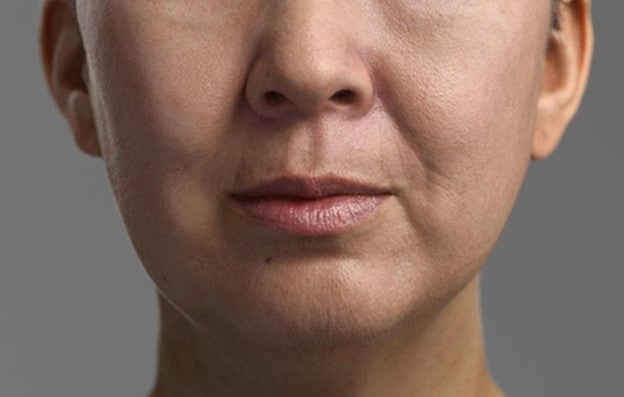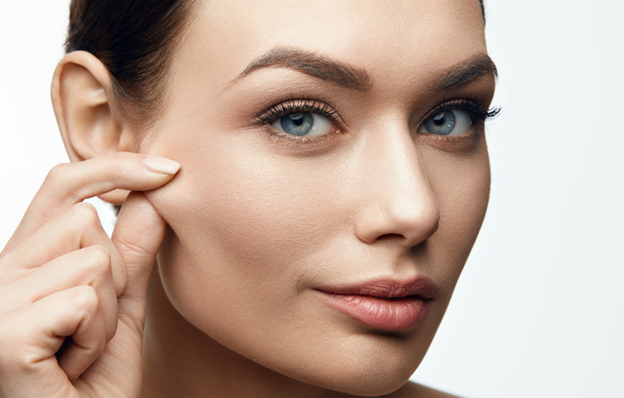
Aging looks different on different people; some are affected by facial volume loss, whereas others are more troubled by sagging skin or skin laxity. Fillers are great for adding volume and contours to the face, or for filling deep lines or wrinkles. Fillers can help with adding a bit of firmness to the skin, but there is only so much fillers can do. Skin laxity, or sagging skin, is mainly a result of collagen loss. Rebuilding collagen naturally is a better option in this case, and it’s actually possible!
Fillers can restore volume and contours but not sagging skin
For those who are mainly troubled by sagging skin, volumising specific parts of the face with fillers, such as the cheeks, will not always provide the desired results. Fillers can also be used to help redefine facial structures affected by facial aging, for example, to create a more defined jawline. This may be the effect that some are looking for, but it will not lead to a more enduring improvement in the structural support for sagging skin.
Worried about looking too “done”?
A lot of people also worry about looking like they have had something “done” and therefore prefer gradual results that manifest over time. This attitude is actually quite common. Some years ago, an online survey was conducted among 383 women who were considering aesthetic anti-aging treatments. As many as 75% of the women said they prefer gradual results that last two years over immediate results lasting 12 months.1
When it comes to skin aging features such as skin laxity or sagging skin, many women (and men!) desire a solution that helps restore skin firmness in a natural way. This is where collagen comes into the picture. If you belong to this group, rebuilding collagen naturally will be key.
Why is collagen important for firm skin and a youthful appearance?
Collagen is a fibrous protein in the deeper layers of our skin. It provides structure and also supports the functions of elastin and the water-binding molecule hyaluronic acid in the skin. In short, collagen helps maintain the skin’s shape, while keeping smoothness and hydration. A healthy supply of collagen means you will have a firm skin and more youthful appearance.
Collagen loss leads to weakened structural support
With age, the collagen structure in the skin starts to fragment and degrade.2 Collagen loss can also happen as a result of environmental factors such as smoking, excessive sun exposure and a high sugar intake.3-6
Collagen loss weakens the skin’s inner structure, leading to lines, wrinkles and folds.7,8
Rebuilding collagen naturally with Sculptra®
If you want to appear more youthful, Sculptra® may be a good choice for you. Sculptra® activates your skin’s ability to rebuild collagen naturally, replacing the structural support lost during aging. Subsequently, it helps renew the skin’s natural firmness.9-12
How Sculptra® activates collagen production
Sculptra® is an injectable collagen treatment based on a biodegradable substance called poly-L-lactic acid, PLLA. PLLA has been used in dissolvable stitches for wound management and in medical implants for more than three decades.13
Sculptra® contains microparticles of PLLA that are injected into the deeper skin layers over a larger area. The microparticles are mixed with sterile water before injection, so the injected volume will have an initial effect that will fill out wrinkles and add volume to the skin. A few days after the injection, the water and other constituents are absorbed by the body while the PLLA microparticles remain in place. You will look like you did before the treatment, yet deep inside the skin, collagen production will increase.
Slowly but surely, Sculptra® will start rebuilding collagen naturally. Fibroblasts, the cells that produce collagen, will produce new collagen that will provide structure to the skin. Since Sculptra® is biodegradable, the Sculptra® microparticles will be dissolved and eliminated over time, but the new collagen remains. This way, Sculptra® renews the skin by restoring skin volume and smoothing wrinkles.12-19
Look younger by activating your collagen production
If you're looking to achieve a more youthful appearance or firm up sagging skin, rather than treating a specific wrinkle or facial feature using a filler, Scuptra® could provide you with a more appropriate option.
If you want to look younger and want to restore sagging skin to firm skin rather than treating a specific wrinkle or adding volume to a specific facial feature – Sculptra® could be a more appropriate option than fillers.
Sculptra® could also be an option if you are looking for gradual and long-lasting results. But what results can you expect and how long-lasting are they? Let’s take a look.
Restore skin thickness and smooth wrinkles for up to two years
Sculptra® has been investigated in several clinical studies. The treatment has been shown to gradually improve skin thickness.12,16,17,19 This is of course beneficial if you are seeking improvement of your skin’s structure and want to restore firm skin.
Sculptra® is also long-lasting. A large clinical study some years ago investigated the effects of Sculptra® over time.
The effects were measured in several ways:
- Firstly, the investigators (the healthcare practitioners treating the patients) evaluated the results of the treatment. The evaluation showed that 86% of patients continued to show improvement up to at least 25 months after the last treatment (the study ended at 25 months).15
- Secondly, patients themselves were asked to evaluate the improvement. As many as 8 out of 10 patients rated Sculptra® as “good” to “excellent” 25 months after the last treatment.20
- Finally, wrinkles were assessed by evaluators. Sculptra® was shown to improve the appearance of wrinkles up to at least 25 months after the last treatment.14,15
Sculptra® could be the right choice if you are looking for a treatment for rebuilding collagen naturally and reducing problems with sagging skin, while achieving long-lasting results.
Three treatment sessions on average
As you might guess, rebuilding collagen naturally in the skin takes time. Sculptra® renews the skin gradually and differs from a filler treatment since you won’t see instant results.
A typical treatment program consists of three treatment sessions over the course of a few months. Contact a qualified healthcare practitioner to find out what would be the best treatment program for you. Find a clinic here.
All aesthetic treatments carry risks and benefits. Be sure to discuss what the procedure involves, possible side effects and aftercare instructions with your healthcare practitioner.
______
Sculptra®, Class III medical device, is a 150 mg poly-L-lactic acid implant liquid for injection by a healthcare professional into or below the skin to improve the volume of depressed areas such as in wrinkles and folds, skin aging and facial fat loss. Sculptra® has risks and benefits. Ask your healthcare professional if Sculptra® is right for you and to explain the possible side effects. Tell them if any side effects concern you. ALWAYS FOLLOW THE INSTRUCTIONS YOU ARE GIVEN. For precautions and contraindications, see www.galdermaaesthetics.com/nz. Unfunded in NZ. Product and treatment costs will apply.
Galderma Australia Pty Ltd, Level 18, 1 Denison St, North Sydney, NSW 2060, Australia. ABN 12 003 976 930. Distributed in NZ by Healthcare Logistics, 58 Richard Pearse Drive, Airport Oaks, Mangere 2022. Phone: 1800 144 944 (AUS), 0800 174 104 (NZ). Fax: +61 (2) 9986 1699. Sculptra® and Galderma are registered trademarks of Galderma Holding S.A. TAPS NP19353. May 2023.
References
- Weinkle S, Lupo M. J Clin Aesthetic Dermatol. 2010;3(9):30-33.
- Fisher GJ et al. Arch Dermatol 2008;144(5):666–72.
- Mukherjee S. Clin Interv Aging. 2006 Dec; 1(4): 327–348.
- Morita A. J Dermatol Sci. 2007 Dec;48(3):169-75. Epub 2007 Oct 24.
- Nguyen HP, Katta R. Skin Therapy Lett. 2015 Nov;20(6):1-5.
- Danby FW. ClinDermatol. 2010 Jul-Aug;28(4):409-11.
- Ganjoo A. Aging skin. In: Venkataram M, ed. ACS(I) Textbook on Cutaneous and Aesthetic Surgery. 1st ed. New Delhi, India: Jaypee Brothers Medical Publishers; 2012:545-549.
- Vleggaar D, Fitzgerald R. J Drugs Dermatol. 2008;7(3):209-220.
- Stein P et al. J DermatolSci 2015;78(1):26–33.9.
- Goldberg D et al. DermatolSurg 2013;39(6):915–22.
- Vleggaar D et al. J Drugs Dermatol 2014;13 (4 suppl):s29–31.
- MoyleGJ et al. HIV Med 2004;5(2):82–7.
- Vleggaar D & Bauer U. J Drugs Dermatol. 2004;3:542–547.
- Narins RS et al. J Am Acad Dermatol 2010;62(3):448–62.
- Brandt FS et al. Aesthet Surg J 2011;31(5):521–8.
- Nelson L and Stewart KJ. J Plast Reconstr Aesthet Surg 2012;65(4):439–47.
- Mest DR and Humble G. Dermatol Surg 2006;32(11): 1336–45.
- Chen HH et al. JAMA Facial Plast Surg 2015;17(1):39–43.
- Valantin MA et al. AIDS 003;17(17):2471–7.
- Brown SA et al. Plast Reconstr Surg 2011;127(4):1684–92.

